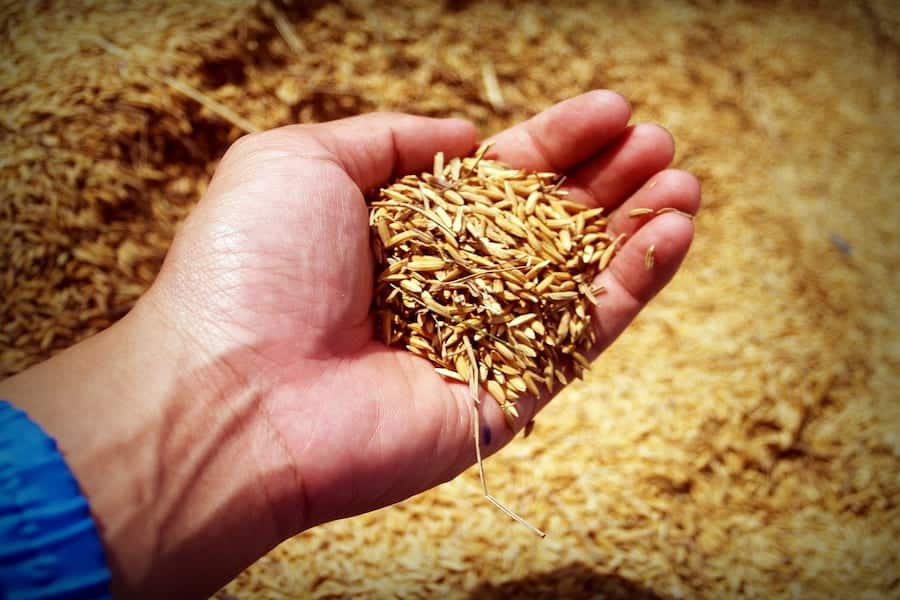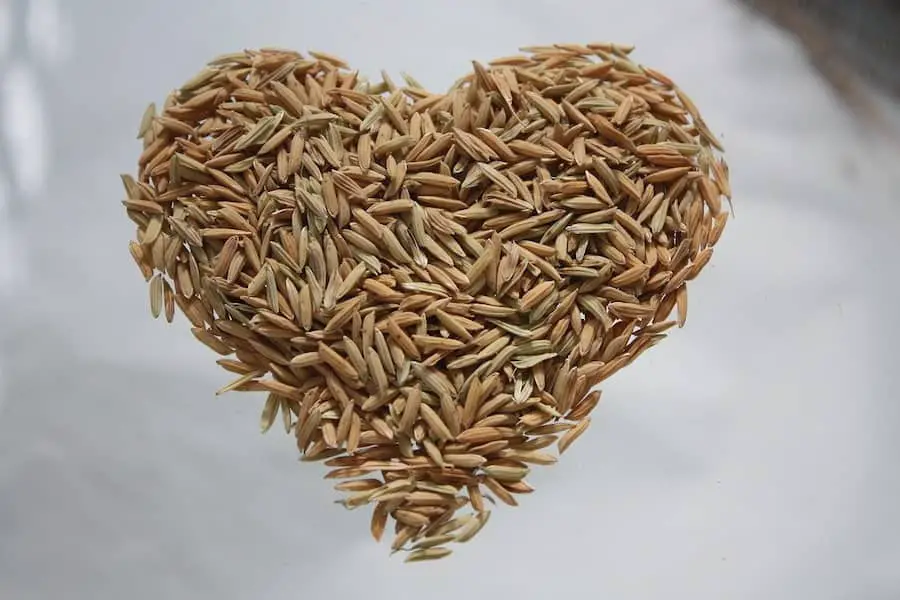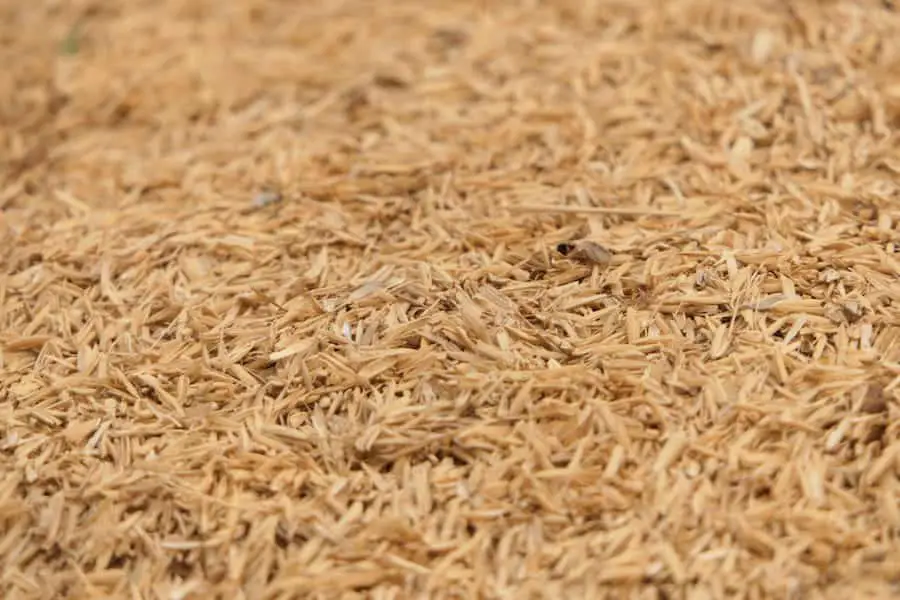How Much Rice Hulls To Use
If yous purchase something through a link in our posts, we may get a small share of the sale.
If your mash gets stuck, you need to add rice hulls every time you are brewing. Despite being a waste later harvesting rice, rice hulls are essential ingredients when brewing all-grain beer. However, about homebrewers accept no thought how many rice hulls to apply in their brews.
Contents
- How Much Rice Hulls to Apply
- Method 1
- Method two
- Which Is the Best Percentage to Use, ten or 15?
- Why Should Yous Add the Rice Hulls?
- How Exercise Rice Hulls Work?
- What are the Disasters of Failing to Utilize Rice Hulls?
- Inefficient Sparge
- Incommunicable Wheat Mash Vorlauf
- Frequently Asked Questions
- Does the Rice Hulls Bear on the Flavor of the Beer?
- Do the Rice Hulls Absorb Water?
- What is the Best Alternative for Rice Hulls?
- Determination
How Much Rice Hulls to Utilise
On average, you lot should utilise enough rice hulls to forestall the mash from getting stuck significantly. Typically, the hulls should contribute to 10 to xv% of the grains used in the mash to provide enough circulation and infiltration.
However, there are two ways of determining the bodily amount of hulls you add to homebrew through calculations. To effigy out exactly the correct amount of ingredients to use, measure the volume or weight using an authentic measuring device, like a scale.
To gain more knowledge, you can also read the best books for homebrewing.

Method 1
- 1.25 Pounds of Naked Pale Rice Malt
- 1.25 Pounds of Naked Beige Rice Malt
- i Pound of Amber Rice Malt
- 9.6 Ounces Crystal Rice Malt
Considering this grain bill written for a one-gallon batch, we narrow it down to the Crystal and Amber rice malts since the naked malts comprise no hulls.
- 1 Pound Amber Rice Malt – 37.five% = 6 Ounces
- 9.6 Ounces Crystal Rice Malt – 37.five% = three.vi Ounces
This implies that the to a higher place grain bill has rice hulls of 9.half dozen Ounces. For proper circulation and infiltration, at least rice hulls of 5.half-dozen Ounces are required in a 3.5 Pounds grain bill.
Method 2
The other method is writing the grain neb presuming that all a hull-less malt is used in the brew and and so adding the rice hulls in the malts that contain hulls.
- 1.25 Pounds Naked Pale Rice Malt
- 1.25 Pounds Naked Beige Rice Malt
- 10 Ounces Amber Rice Malt
- 6 Ounces Crystal Rice Malt
Once more, we are left with the Amber and Crystal rice malts.
- 10 Ounces Amber Rice Malt X 60% = six Ounces
- 6 Ounces Crystal Rice Malt Ten 60% = 3.half-dozen Ounces
The ii calculations work out the same, but the last is preferred equally it efficiently calculates the hull-less malt for any item brewing recipe. However, even though a grain pecker is a scrap heavy on non-rice malts, the rice malt in the recipe above provides most of the required rice hulls.
Which Is the All-time Per centum to Utilise, ten or 15?
Typically, when 10% of rice hulls are used to brew high percentages of naked rice malts, the mash ends upward stuck chiefly. If not bad, yous volition detect that you lot get half-cooked rice bits when you mash using milled rice malt, unlike when using buckwheat and millet, which release soft powdery starches into the hull.
For this reason, you should use 15% rice hulls when using a grain beak of loftier percentage naked rice malt to brew for good circulation and filtration. Hulled rice malt beers usually practice not outcome in stuck mashes since they take 37.5% rice hulls, which occur naturally.
And so, when brewing using rice malt, you tin utilise ten% of rice hulls if the rice malt is less than a quarter of the grain nib. If the rice malt exceeds a quarter, you can apply upwards to xv% rice hulls.
Why Should You Add together the Rice Hulls?
Mashes with over 50% huskless grains or malts require rice hulls to sparge. Sparging takes more fourth dimension if absent or added in low amounts, thus breaking the workflow.
Most importantly, the hulls practice not change the flavor of the brew. You can add them to the mash by mixing them with other dry out grains earlier infusing them using hot water.

It would help if you ever use rice hulls when brewing loftier gravity beer, especially for recipes requiring high percentages of specialty malts for rye and wheat beers. The grain contains higher beta-glucan and protein levels than barley grains. These two elements determine the viscosity of the wort.
How Do Rice Hulls Piece of work?
The hulls are kickoff washed and and then dried to remove colour and flavour. This way, they can infiltrate the wort out of the mash. They create space around the gritty mash particles to ensure that the wort efficiently flows out of the mash tun.
Rice hulls are platonic for preventing a stuck sparge, because they are cheap and exercise not alter the wort's color and flavor.
What are the Disasters of Failing to Use Rice Hulls?
Sparging without rice hulls is unsafe to your brew. It might involve the following disasters.
Inefficient Sparge
Every high-quality mash ought to be spongy just business firm. It should permit water to evenly pass through the lauter to leach out the sugars and make them more than accessible in the conversion process. Too the mash'due south pasty elevation, the lauter will as well get hard, compacted, and brick-similar.
Eventually, h2o will make it through the lauter in tiny amounts, thus, forming rivulets and fissures. If this fails, a lot of the sugar is left behind in the conversion process. Withal, y'all can unstick the brew through stirring.
Stirring will likewise render vorlauf unnecessary while assuring many proteins in the brewing kettle. The problem with stirring the stuck brew is it will still become stuck once more afterward some fourth dimension. In this example, the virtually sensible thing to do is use rice hulls every time you are brewing heavily offshoot beer.
Impossible Wheat Mash Vorlauf
Since wheat malt has already been dehusked, you are left with nothing but a lite shell with a crunchy endosperm interior which converts to mush after mashing. The mush is then filtered dorsum through the lauter in the process of recirculation or vorlauf.
However, if a lower percentage of rice hulls was used, i.e., less than x%, the wheat grants a much wide viscous movie elevation, making the cloudy wort impossible to pass through the mash. In this case, fifty-fifty stirring or trying to cut across the top is non practical.

Ofttimes Asked Questions
Does the Rice Hulls Affect the Flavor of the Beer?
No, rice hulls do not affect the taste of the beer but instead aid in the lautering procedure. Still, their usage depends on the type of beer you intend to make and your brew tun's geometry.
Do the Rice Hulls Absorb Water?
Rice hulls absorb water from 5% to sixteen% of the unit of measurement weight. Ash from the hulls has well-nigh ninety% silica, which is lightweight and porous with a high surface area. Consider soaking your rice hulls in h2o before mashing to minimize their possibility of absorbing water.
What is the Best Alternative for Rice Hulls?
When information technology is challenging to observe rice hulls, yous tin use oat hulls or oat grain shells. Oat hulls are good filters despite existence inedible, and just similar rice hulls, they practise not add or remove anything to the wort. Primarily, they are used when brewing wheat beers or rye, just like rice hulls.
Conclusion
We've seen that a suitable rice hulls percentage to add to the mash should be 10 to 15% of the grain bill, which is roughly i pound to one.five pounds for a 5-gallon batch. This data will uncertainly assistance whatever novice homebrewer in making an unstuck mash.
How Much Rice Hulls To Use,
Source: https://beer-snobs.com/how-much-rice-hulls-use/#:~:text=On%20average%2C%20you%20should%20use,provide%20enough%20circulation%20and%20infiltration.
Posted by: mcglonelibse1995.blogspot.com


0 Response to "How Much Rice Hulls To Use"
Post a Comment